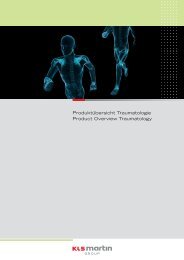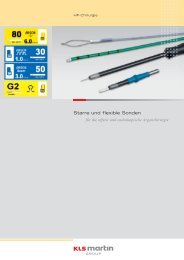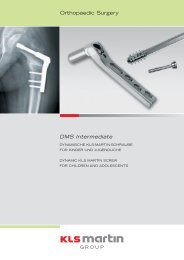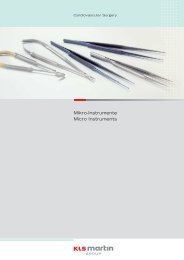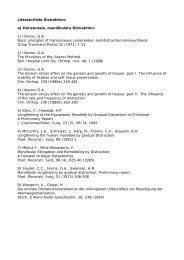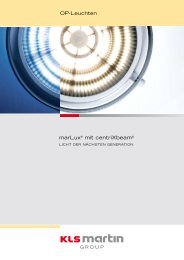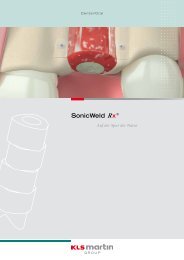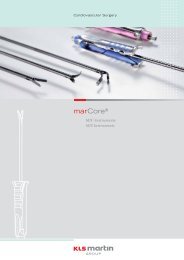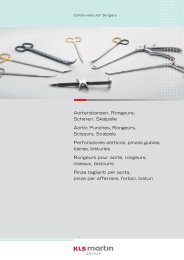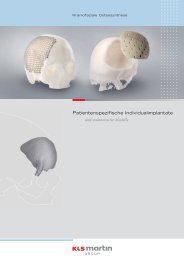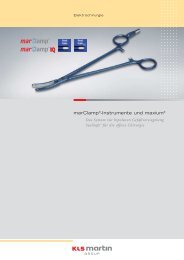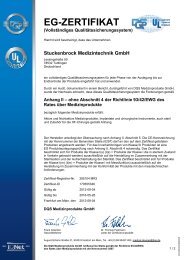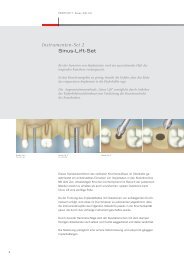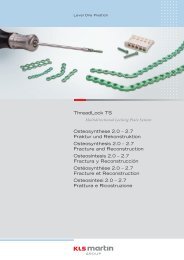Kryptonite - KLS Martin
Kryptonite - KLS Martin
Kryptonite - KLS Martin
You also want an ePaper? Increase the reach of your titles
YUMPU automatically turns print PDFs into web optimized ePapers that Google loves.
CMF Surgery<br />
<strong>Kryptonite</strong><br />
Cranioplasty Case Reports and Early<br />
Experience with <strong>Kryptonite</strong> Bone Cement<br />
as a Cranial Bone Void Filler<br />
■ Adhesive<br />
■ Porous<br />
■ Bone-like Properties<br />
■ Low Exotherm<br />
■ Non-toxic
<strong>Kryptonite</strong> Bone Cement is non-toxic, with bone-like<br />
mechanical properties, and composed of naturally<br />
occurring fatty acids and calcium carbonate. The unique<br />
properties of <strong>Kryptonite</strong> Bone Cement make it well<br />
suited for cranial applications and distinguish it from<br />
PMMA and tricalcium phosphate/hydroxyapatite based<br />
products.<br />
<strong>Kryptonite</strong> Bone Cement can be mixed and delivered<br />
by hand or utilizing a number of commercially available<br />
mixing systems.
<strong>Kryptonite</strong>: Bone Cement<br />
<strong>Kryptonite</strong><br />
Cranioplasty Case Reports and Early<br />
Experience with <strong>Kryptonite</strong> Bone Cement<br />
as a Cranial Bone Void Filler<br />
Abstract<br />
Two cranial repair cases are presented in which <strong>Kryptonite</strong> Bone Cement was<br />
used to fill bone voids. In the first case, a 63-year-old female with a basiloma<br />
adjacent a preexisting 25 cm 2 occipital defect underwent cranioplasty with<br />
<strong>Kryptonite</strong> Bone Cement. At 5-month follow up, the implant was stable,<br />
neurological assessment was normal and the patient had resumed recreational<br />
activity.<br />
In the second case, a surgical technique is described for filling a cranial void<br />
following excision of an eosinophilic granuloma.<br />
Lastly, a review of 27 cranioplasty procedures is presented. These cases report<br />
no device-related adverse events, demonstrating the safety profile of this unique<br />
bone void filler in cranial applications.<br />
<strong>Kryptonite</strong> material has received a CE mark for use in Europe as a self-setting bone<br />
filler for bony voids or gaps that are not intrinsic to the stability of the bony structure.<br />
<strong>Kryptonite</strong> material is a resinous material for the repair of bony defects that may be<br />
shaped and gently applied to cranial defects.<br />
<strong>Kryptonite</strong> material has regulatory clearance in Australia (TGA) and in Canada<br />
(Health Canada Approved).<br />
<strong>Kryptonite</strong> material has obtained marketing authorization from the United States<br />
Food and Drug Administration as a bone cement with indications for use as a resinous<br />
material for filling cranial defects.<br />
3
Background<br />
4<br />
<strong>Kryptonite</strong>: Bone Cement<br />
<strong>Kryptonite</strong><br />
Cranioplasty Case Reports and Early<br />
Experience with <strong>Kryptonite</strong> Bone Cement<br />
as a Cranial Bone Void Filler<br />
Documented cranioplasty procedures date back to the 16 th century<br />
when gold plates were used to fill voids created by trepanation.<br />
Through the following centuries, surgeons have explored<br />
the use of xenografts, allografts, autografts, metals and modern<br />
plastics in the search of a safe and effective cranioplasty solution.<br />
Polymethylmethacrylate (PMMA) has become the standard of<br />
care and has excellent mechanical properties, but it does exhibit<br />
several deficiencies.<br />
■ During the polymerization process PMMA can reach temperatures<br />
in excess of 93°C; hot enough to necrose neural tissue.<br />
■ The structure of PMMA does not allow osseointegration, and<br />
the material is frequently walled off from the host bone by a<br />
layer of fibrous tissue. PMMA contains a toxic monomer that<br />
is a health concern for the operating room staff and has the<br />
potential to leach from the product and into the host tissue.<br />
■ PMMA is not adhesive and instead simply fills the space into<br />
which it is implanted, thus relying on geometric features to<br />
maintain its position.<br />
More recently, calcium phosphate based osteoconductive cements<br />
have been used clinically. Although these materials allow for bone<br />
ingrowth, their mechanical properties, most notably their tensile<br />
strengths, are significantly lower than PMMA, and implant failures<br />
have been reported. 1<br />
<strong>Kryptonite</strong> Bone Cement, a novel in situ curing structural<br />
adhesive that polymerizes to form a porous scaffold, 2 offers the<br />
potential to address the limitations of these historical solutions<br />
and provides a safe and efficacious means of repairing cranial<br />
defects.
CT axial scan and reconstruction of occipital defect<br />
filled with 10 cc kit of <strong>Kryptonite</strong> Bone Cement<br />
Case 1<br />
Cranioplasty reoperation for basiloma /<br />
cranial meningocele<br />
A 63-year-old female, non-smoker presented with a large basiloma<br />
adjacent an occipital defect present from an earlier pediatric<br />
cranial meningocele. The defect measured approximately 25 cm 2<br />
and was positioned over the occipital midline. After excision<br />
of the tumor, scar tissue within the defect was removed, bone<br />
was exposed, and the area was rinsed clean with saline.<br />
A 10 cc kit of <strong>Kryptonite</strong> Bone Cement was mixed per the<br />
manufacturer’s instructions, delivered to the defect and contoured<br />
to conform to the patient’s occipital anatomy. Upon placement,<br />
the material was allowed to cure for an additional 30 minutes,<br />
at which time it was sufficiently rigid to maintain its shape.<br />
The incision was closed per standard technique, the patient was<br />
sent to postoperative care and no immediate postoperative<br />
complications were noted.<br />
The patient returned to the clinic five months after surgery. She<br />
was taking no medications, had resumed moderate recreational<br />
activity and in assessing the surgical outcome, she reported being<br />
“very satisfied” with the treatment. Her neurological assessment<br />
was normal and KPS (Karnofsky Performance Status) score was<br />
100. CT scans showed an intact implant that had maintained its<br />
original position.<br />
5
Case 2<br />
6<br />
<strong>Kryptonite</strong>: Bone Cement<br />
Preoperative MRI showing eosinophilic granuloma Cranial defect before and after application of <strong>Kryptonite</strong> Bone Cement<br />
Cranioplasty after excision of Eosinophilic Granuloma<br />
A child presented with an eosinophilic granuloma that was<br />
excised per standard techniques that required cranioplasty on<br />
an approximately 2 cm diameter defect. In shaping the defect,<br />
the surgeon created an undercut geometry such that the exterior<br />
diameter of the defect was narrower than the internal diameter,<br />
providing a shape to resist expulsion of the implant. The surgeon<br />
positioned the patient with the defect parallel to the floor to<br />
prevent the material from flowing out of the defect during initial<br />
polymerization.<br />
<strong>Kryptonite</strong> Bone Cement was mixed per the manufacturer’s<br />
instructions and allowed to partially polymerize in the mixing<br />
dish for 10 minutes prior to handling. The defect was irrigated<br />
with saline and gel foam was placed over the dura. Once the<br />
material had reached an adhesive state it was placed in the<br />
defect using a spatula. Accounting for the expansion that occurs<br />
during the polymerization process, the void was only half filled,<br />
and during the next 10 minutes the material expanded to completely<br />
fill the void. Wet surgical gloves were used for final contouring<br />
of the material. A surgical sponge was lightly pressed<br />
against the <strong>Kryptonite</strong> Bone Cement material to assess<br />
the state of adhesiveness. When the sponge no longer adhered<br />
the incision was closed per standard technique.
Review of Early Experience with <strong>Kryptonite</strong><br />
Bone Cement as Cranial Bone Void Filler<br />
<strong>Kryptonite</strong> Bone Cement is CE-marked, TGA cleared in Australia<br />
and Health Canada approved for human clinical use and has been<br />
used in approximately 3,000 human clinical cases throughout<br />
Europe, Latin America, and Canada. Due to the relative infrequency<br />
of cranioplasty procedures, only a small number of these 3,000<br />
cases utilized <strong>Kryptonite</strong> Bone Cement as a cranioplasty<br />
cement.<br />
Doctors Research Group, Inc. is aware of 38 such cases through<br />
2008 and undertook the effort of collecting retrospective clinical<br />
data on this patient population. Twenty-seven patients consented<br />
to participation in the retrospective chart review and interview,<br />
and 14 of these agreed to a follow-up CT scan. A summary of<br />
the patient demographic data is provided below:<br />
Attribute Result<br />
Sex Male: 12<br />
Female: 15<br />
Age Mean: 50 years<br />
Mean Female: 55 years<br />
Mean Male: 43 years<br />
Race Caucasian: 26<br />
African: 1<br />
Smoker Current: 6<br />
Non: 19<br />
Former: 2<br />
The clinical conditions that required cranioplasty were varied<br />
and included among others: meningioma, cranial vault decompression,<br />
drug resistant epilepsy and reconstruction of skull base<br />
after endonasal transtubercular-transplanar approach. These 27<br />
procedures are considered to be representative of all cranioplasty<br />
procedures.<br />
Time points for follow-up ranged from six weeks to 18 months.<br />
Out of 23 patients providing feedback, 21 responded that they<br />
were “very satisfied” or “somewhat satisfied” with the surgical<br />
outcome. In the 27 cranioplasty cases, there have been no neurological<br />
complications or abnormalities, no implant rejections, and<br />
no other device-related effects. The cases serve to demonstrate<br />
<strong>Kryptonite</strong> Bone Cement’s respectable safety profile. There<br />
were no instances of infections secondary to <strong>Kryptonite</strong> Bone<br />
Cement failure, as is often observed in cranial defects treated<br />
with hydroxyapatite-based cements. 3 Review of the 14 follow-up<br />
CT scans (average 5-10 months post-op) by an independent<br />
radiologist showed no evidence of device failure or abnormal<br />
occurrence.<br />
Discussion<br />
With respect to the first case, long term survivorship and normal<br />
physical function is not the normal outcome for pediatric cranial<br />
meningocele patients. 4 This patient beat the odds but, like others<br />
with her condition, has undergone several surgical interventions<br />
during her lifetime.<br />
To improve survivorship in such patients, and to generally improve<br />
the outcomes of cranioplasty procedures, there exists a need for<br />
an in situ curing material with adequate strength, low exotherm,<br />
adhesiveness to bone, low toxicity, and porous structure. Laboratory<br />
testing has shown <strong>Kryptonite</strong> Bone Cement satisfies these<br />
requirements and recent clinical successes like those presented<br />
here are further proving its safety and efficacy.<br />
The surgical technique described in the second case report highlights<br />
the subtle differences in handling and polymerization rate<br />
relative to both PMMA and calcium phosphate based void fillers.<br />
Additionally, <strong>Kryptonite</strong> Bone Cement’s adhesiveness and in situ<br />
expansion are unique characteristics that should be appre-ciated<br />
by the surgeon prior to initial use. Familiarity with the product,<br />
gained through hands-on evaluation and training from experienced<br />
users, will lead to predictable use and desirable outcomes with<br />
this truly novel product.<br />
References:<br />
1. Goldberg et al<br />
“Measuring pulsatile forces on the human cranium”,<br />
Journal of Craniofacial Surgery,<br />
16 (1), pp 134-139, 2005.<br />
2. Data on file at Doctors Research Group, Inc.<br />
3. Moriera-Gonzalez et al<br />
“Clinical outcome in cranioplasty: critical review in<br />
long-term follow-up”,<br />
Journal of Craniofacial Surgery, 14(2):144-153, 2003.<br />
4. Althouse R and Wald N<br />
“Survival and handicap of infants with spina bifida,”<br />
Arch Dis Child, November;<br />
55 (11): 845-850, 1980.<br />
7
<strong>KLS</strong> <strong>Martin</strong> Group<br />
Karl Leibinger GmbH & Co. KG<br />
78570 Mühlheim . Germany<br />
Tel. +49 7463 838-0<br />
info@klsmartin.com<br />
<strong>KLS</strong> <strong>Martin</strong> GmbH + Co. KG<br />
79224 Umkirch . Germany<br />
Tel. +49 7665 98 02-0<br />
info@klsmartin.com<br />
Stuckenbrock Medizintechnik GmbH<br />
78532 Tuttlingen . Germany<br />
Tel. +49 74 61 16 58 80<br />
verwaltung@stuckenbrock.de<br />
07.11 . 90-820-02-05 . Printed in Germany · © 2009 Doctors Research Group, Inc. · Alle Rechte vorbehalten · Technische Änderungen vorbehalten<br />
We reserve the right to make alterations · Cambios técnicos reservados · Sous réserve de modifications techniques · Ci riserviamo il diritto di modifiche tecniche<br />
Intended for International Distribution<br />
Rudolf Buck GmbH<br />
78570 Mühlheim . Germany<br />
Tel. +49 74 63 99 516-30<br />
info@klsmartin.com<br />
<strong>KLS</strong> <strong>Martin</strong> France SARL<br />
68000 Colmar . France<br />
Tel. +33 3 89 21 6601<br />
france@klsmartin.com<br />
<strong>Martin</strong> Italia S.r.l.<br />
20059 Vimercate (MB) . Italy<br />
Tel. +39 039 605 6731<br />
italia@klsmartin.com<br />
<strong>Kryptonite</strong> material has received a CE mark for use in Europe as a self-setting<br />
bone filler for bony voids or gaps that are not intrinsic to the stability of the bony structure.<br />
<strong>Kryptonite</strong> material is a resinous material for the repair of bony defects that may be<br />
shaped and gently applied to cranial defects.<br />
<strong>Kryptonite</strong> material has regulatory clearance in Australia (TGA) and in Canada<br />
(Health Canada Approved).<br />
<strong>Kryptonite</strong> material has obtained marketing authorization from the United States<br />
Food and Drug Administration as a bone cement with indications for use as a resinous<br />
material for filling cranial defects.<br />
Manufactured by:<br />
Doctors Research Group, Inc.<br />
574 Heritage Road, Suite 202<br />
Southbury, CT 06488 USA<br />
1-203-262-9335<br />
Made in the USA<br />
Distributed by:<br />
Gebrüder <strong>Martin</strong> GmbH & Co. KG<br />
A company of the <strong>KLS</strong> <strong>Martin</strong> Group<br />
Ludwigstaler Str. 132 · 78532 Tuttlingen · Germany<br />
Postfach 60 · 78501 Tuttlingen · Germany<br />
Tel. +49 7461 706-0 · Fax +49 7461 706-193<br />
info@klsmartin.com · www.klsmartin.com<br />
<strong>Martin</strong> Nederland/Marned B.V.<br />
1270 AG Huizen . The Netherlands<br />
Tel. +31 35 523 45 38<br />
nederland@klsmartin.com<br />
Nippon <strong>Martin</strong> K.K.<br />
Osaka 541-0046 . Japan<br />
Tel. +81 6 62 28 9075<br />
nippon@klsmartin.com<br />
<strong>KLS</strong> <strong>Martin</strong> L.P.<br />
Jacksonville, Fl 32246 . USA<br />
Tel. +1 904 641 77 46<br />
usa@klsmartin.com<br />
Gebrüder <strong>Martin</strong> GmbH & Co. KG<br />
Representative Office<br />
121471 Moscow . Russia<br />
Tel. +7 499 792-76-19<br />
russia@klsmartin.com<br />
Gebrüder <strong>Martin</strong> GmbH & Co. KG<br />
Representative Office<br />
201203 Shanghai . China<br />
Tel. +86 21 2898 6611<br />
china@klsmartin.com<br />
Gebrüder <strong>Martin</strong> GmbH & Co. KG<br />
Representative Office<br />
Dubai . United Arab Emirates<br />
Tel. +971 4 454 16 55<br />
middleeast@klsmartin.com



